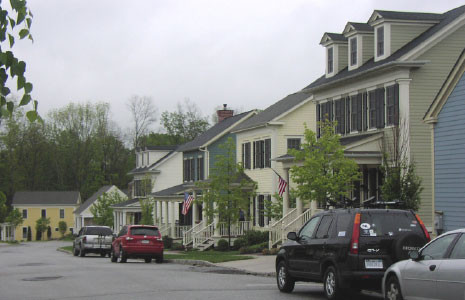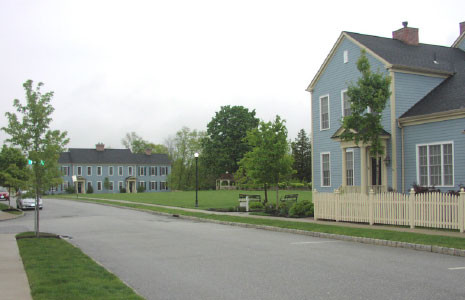

-
Place type
New Neighborhoods (directly related)
-
Location
Warwick Village, New York (50 miles northwest of New York City in Orange County)
-
Site
310-acre site, less than one mile from village center.
-
Program
215-unit residential neighborhood (restricted to adults age 55+) containing 31 townhomes, 154 detached single-family homes and 30 condominiums, a community center, village greens and a post office.
-
Developer
Warwick Grove Company, LLC, an affiliate of LeylandAlliance LLC and Tarragon Corporation. Master Plan consultants Duany Plater-Zyberk
Nature
This site is dominated by wetlands. In order to preserve wildlife habitats (including wetlands) the buildings and dwellings are concentrated into four relatively compact neighborhoods, leaving the rest of the site undeveloped. There are also guidelines for other public realm elements such as sidewalks, curbs, fences, walls and street furniture.
Links
Warwick Grove is within walking distance of the public library and the village’s Main Street. A path through Memorial Park creates easy connectivity between Warwick Grove and the village center.
Communities
The site contains a community center and is within walking distance of a park, post office, public library and the village’s Main Street.
Tools and Actions
In the late 1990s the Town of Warwick received a New York State Quality Communities Grant. It used this grant to undertake a town-wide master planning effort, educate the public about planning, and conduct land use and zoning studies. Focal issues in the planning process were farmland preservation and addressing the impact of development. In 1999, the Town Board adopted a new Comprehensive Master Plan. One of its main themes was to protect farmland by steering population growth into its three village centers, one of them being Warwick Village. While considering a revision of its zoning code, in 2001, a one-year building moratorium was imposed.
In 2001 the Township revised its zoning code. Highlights included density reductions through incentives to cluster development and a modified Transfer of Development Rights program. The new zoning code also created agricultural and water conservation districts.
New zoning regulations, coupled with improved communication between village and town officials, appear to be succeeding at directing new growth toward existing vibrant villages such as Warwick Grove while protecting a nearly $70 million/year agriculture industry.
In addition, in 2000 Warwick voters passed a $9.5 million purchase of development rights bond issue. The village can use this money to purchase the development rights of farm properties and open space. The land remains farmland in perpetuity while farmers receive money that they put towards modernizing operations or meeting other expenses. This helps them deal with financial needs without selling their land to developers. To date, 2200 acres have been or are being preserved.